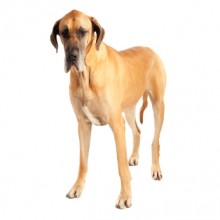Great Dane
Lifestyle Needs

The Great Dane is a giant of a dog who needs a large house with a large garden. He loves his family, typically gentle and dignified in his manner and also an excellent guard dog. He requires more than two hours exercise every day and does not like to be left alone. His short coat is easy to groom and keep clean. Needless to say, he is expensive to keep. His average lifespan is under 10 years.
Genetic Diversity
(Known as Coefficient of Inbreeding: 'COI'. It should be as low as possible.)
The UK Kennel Club breed average COI is 5.2% - See 'A Beginners Guide to COI'
Gene Pool Size
(Known as Effective Population Size: 'EPS')
166.8
EPS is a measure of how many individuals are contributing genetically to a breed population. It is a measure of the size of the gene pool in a breed. Lower than 100 is considered critical by conservationists and below 50 brings a breed close to extinction. For more information see the Kennel Club article.
Health and Welfare Problems due to Conformation
(Body shape and physical characteristics)
- Gastric dilatation volvulus Very common is this breed due to selection for large size and deep-chested conformation. Prevalence 42%)
- Medial canthal pocket syndrome (upper and lower eyelids in inside corner of the eye roll outwards creating a ‘pocket’ in which irritating substances such as dirt and dust can collect)
BVA/KC Health Schemes: www.bva.co.uk/chs
- Hip dysplasia: breed 5 year mean score 10.4 (parents should be lower)
- Elbow dysplasia: ideally O:O
- Eye disease: Goniodysgenisis / Primary glaucoma (annual testing)
Estimated Breeding Values (EBVs) : No EBVs are currently available for this breed
www.thekennelclub.org.uk/about-ebvs
DNA Tests Available
DogWellNet and IPFD Harmonisation of Genetic Testing for Dogs (HGTD)
www.dogwellnet.com/breeds
- Inherited Myopathy of Great Danes (IMGD)
Availability of a DNA test does not mean that it is always necessary or even desirable for breeders to use this test.
Other Breed-Specific Health Screening Schemes
- Heart testing (Dilated Cardiomyopathy)
- Bitches not to produce a litter under two years of age
Ask the breeder to show you the certificates for the above tests/screening for both parents. If any of the above tests have not been considered necessary by the breeder (and there may be good reasons), ask her to explain why.
Other Diseases Reported
(For which there are currently no genetic or screening tests for sire or dam)
- Cancer: Osteosarcoma
- Osteochondrosis – shoulder, elbow and stifle
- Cervical vertebral malformation syndrome (Wobbler syndrome)
- Ectropion
- Cherry eye
Ask the breeder about the medical history of the parents, grandparents and great grandparents. Consider carefully whether to purchase a puppy if some of these or other diseases are in the family line.
Ask about the breeder’s policy in cases of serious genetic diseases occurring to your puppy in later life. Good breeders will request to be informed of such events in order to improve future breeding decisions.
You are strongly advised to buy from a breeder who uses (or is prepared to use) the AWF Puppy Contract and Puppy Information Pack (PIP): www.puppycontract.org.uk
The breeder should also be familiar with the CFSG/DBRG Code of Practice for Dog Breeding